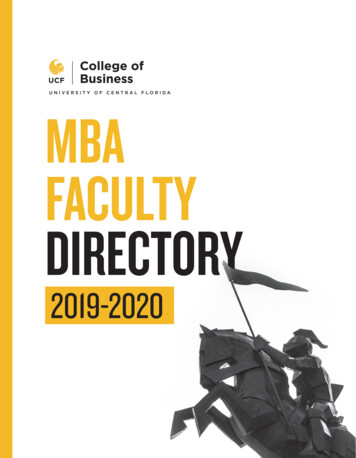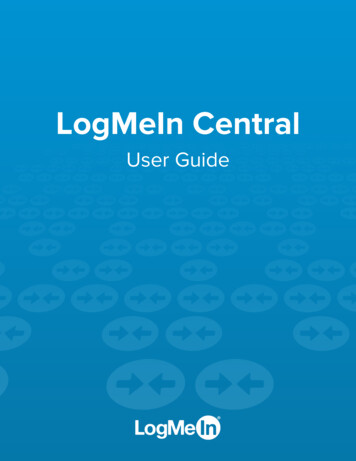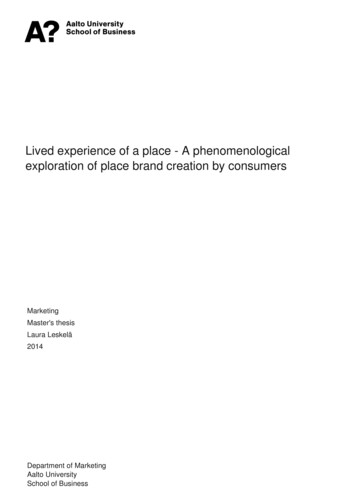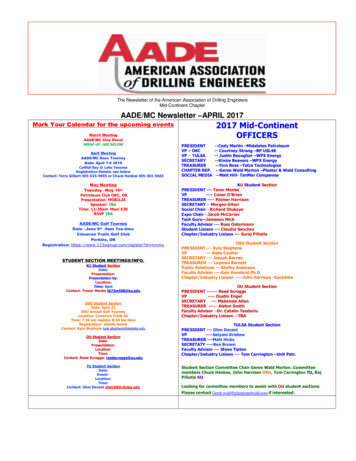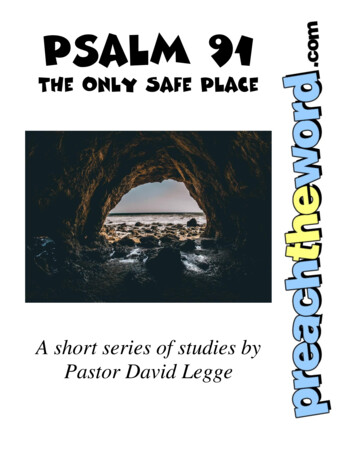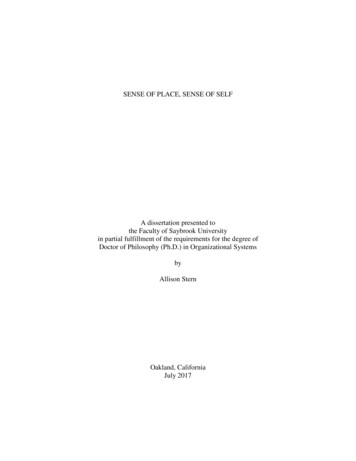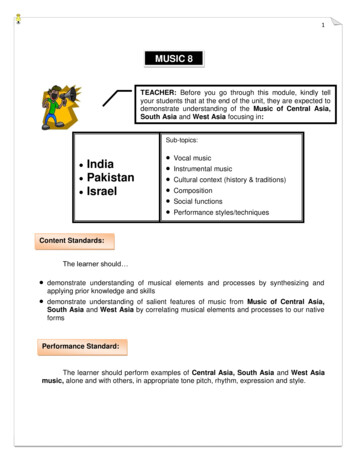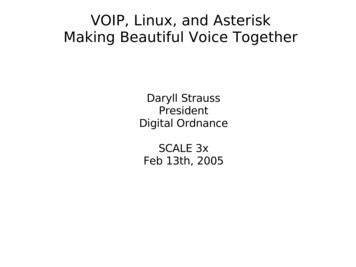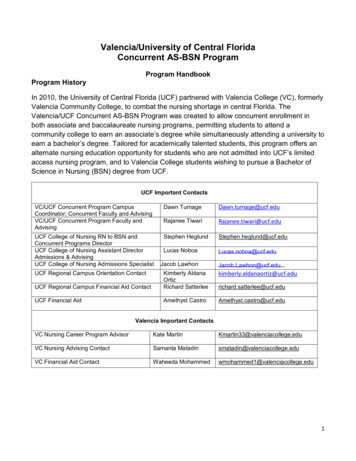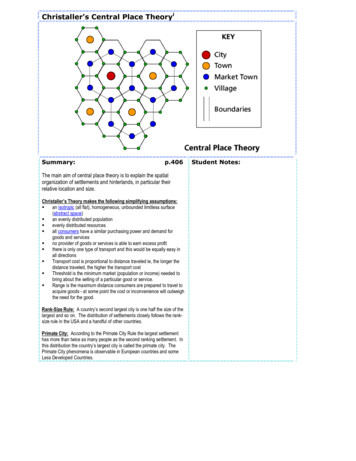
Transcription
Christaller’s Central Place TheoryiSummary:p.406The main aim of central place theory is to explain the spatialorganization of settlements and hinterlands, in particular theirrelative location and size.Christaller’s Theory makes the following simplifying assumptions: an isotropic (all flat), homogeneous, unbounded limitless surface(abstract space) an evenly distributed population evenly distributed resources all consumers have a similar purchasing power and demand forgoods and services no provider of goods or services is able to earn excess profit there is only one type of transport and this would be equally easy inall directions Transport cost is proportional to distance traveled ie, the longer thedistance traveled, the higher the transport cost Threshold is the minimum market (population or income) needed tobring about the selling of a particular good or service. Range is the maximum distance consumers are prepared to travel toacquire goods - at some point the cost or inconvenience will outweighthe need for the good.Rank-Size Rule: A country’s second largest city is one half the size of thelargest and so on. The distribution of settlements closely follows the ranksize rule in the USA and a handful of other countries.Primate City: According to the Primate City Rule the largest settlementhas more than twice as many people as the second ranking settlement. Inthis distribution the country’s largest city is called the primate city. ThePrimate City phenomena is observable in European countries and someLess Developed Countries.Student Notes:
Rostow’s Model of Economic DevelopmentiSummaryP.316In 1960, the American Economic Historian, WW Rostow suggested that countries passed through five stages of economic development.Stage 1 Traditional SocietyThe economy is dominated by subsistence activity where output is consumed by producers rather than traded. Any trade is carried out bybarter where goods are exchanged directly for other goods. Agriculture is the most important industry and production is labor intensive usingonly limited quantities of capital. Resource allocation is determined very much by traditional methods of production.Stage 2 Transitional Stage (the preconditions for takeoff)Increased specialization generates surpluses for trading. There is an emergence of a transport infrastructure to support trade. As incomes,savings and investment grow entrepreneurs emerge. External trade also occurs concentrating on primary products.Stage 3 – Take-offIndustrialization increases, with workers switching from the agriculture sector tothe manufacturing sector. Growth is concentrated in a few regions of the country and in one or two manufacturing industries. The level ofinvestment reaches over 10% of GNP.The economic transitions are accompanied by the evolution of new political and social institutions that support the industrializations. Thegrowth is self-sustaining as investment leads to increasing incomes in turn generating more savings to finance further investment.Stage 4 Drive to MaturityThe economy is diversifying into new areas. Technological innovation is providing a diverse range of investment opportunities. The economy isproducing a wide range of goods and services and there is less reliance on imports.Stage 5 High Mass ConsumptionThe economy is geared towards mass consumption. The consumer durable industries flourish. The service sector becomes increasinglydominant.According to Rostow development requires substantial investment in capital. For the economies of LDCs to grow the right conditions for suchinvestment would have to be created. If aid is given or foreign direct investment occurs at stage 3 the economy needs to have reached stage 2.If the stage 2 has been reached then injections of investment may lead to rapid growth
Immanuel Wallerstien’s Core-Periphery ModeliSummary:p.322The world can be perceived as a core / periphery dichotomy wherecore countries are characterized by high levels of development, acapacity at innovation and a convergence of trade flows. The corehas a level of dominance over the periphery which is reflected intrade and transportation. Accessibility is higher within the elementsof the core than within the periphery. Most of high level economicactivities and innovations are located at the core, with theperiphery subjugated to those processes at various levels. Thispattern was particularly prevalent during the colonial era where thedevelopment of transport systems in the developing world mainlyfavored the accessibility of core countries to the resources andmarkets of the periphery, a situation that endured until the 1960sand 1970s. The semi-periphery has a higher level of autonomy andhas been the object of significant processes of economicdevelopment (China, Brazil, Malaysia, etc.). Concomitantly, theaccessibility of the semi-periphery improved, permitting theexploitation of its comparative advantages in labor and resources.Recent changes in globalization, particularly industrial growth indeveloping countries, is challenging this representation.Student Notes:
Alfred Weber’s Model of Industrial LocationSummary:Economic GeographerGerman 1868 – 1958Set of assumptions in order to minimize the complexities of thereal world Most raw materials are localized, i.e., found only in certainlocations and the location(s) is (are) known --e.g., energy Labor is found only in certain location (Not mobile), fixedwage,unlimited quantity Markets are fixed known locations The cost of transporting raw material, energy, and finishedproduct is a direct function of weight and distance: thegreaterthe distance, the greater the cost; the greater the weight thegreater the cost. perfect economic competition: there is nomonopoly for any producer; many sellers and buyers. Isotropic plain (physically, politically and culturally uniformplain) Industrialists are economic operators: interested inminimizing cost and maximizing profit Some raw materials are ubiquitous (found everywhere, e.g.,water) he recognized general factors such as transportationcosts and special factors such as perish ability of food decidedthat it was transportation cost that was the critical determinantof regional industrial locationStudent Notes:
Bid-rent TheorySummary:Bid rent theory is a geographical economic theorythat refers to how the price and demand on realestate changes as the distance towards the CentralBusiness District (CBD) increases. It states thatdifferent land users will compete with one anotherfor land close to the city centre. This is based uponthe idea that retail establishments wish to maximizetheir profitability, so they are much more willing topay more money for land close to the CBD and lessfor land further away from this area. This theory isbased upon the reasoning that the more accessiblean area, the more profitable.Student Notes:
Unit Six: Industrialization and Economic DevelopmentAcid depositionAcid precipitationActive solar energysystemsAgglomerationAir pollutionBiodiversityBiomass fuelBreak-of-bulk pointBreeder reactorBulk-gaining industryBulk-reducing ervationConsumer goodsCottage industryDependency TheoryDevelopmentEcotourismEnergy ConsumptionEnfranchisementEntrepotFissionFootloose industryFordistForeign directinvestmentFossil fuelThe accumulation of acids or acidic compounds on the surface of the Earth, in lakes orstreams, or on objects or vegetation near the Earth's surface, as a result of their separationfrom the atmospherePrecipitation abnormally high in sulfuric and nitric acid content that is caused byatmospheric pollutants.A system designed to convert solar radiation into usable energy for space, water heating, orother uses. It requires a mechanical device, usually a pump or fan, to collect the sun'senergy.A concentration of services clustered together; the lower the cost of production (firms havecompeting multiple suppliers, greater specialization and division of labor result) and thegreater the market that the firm can sell into.The addition of harmful chemicals to the atmosphere. The most serious air pollution resultsfrom the burning of fossil fuels, especially in internal-combustion engines.The number and variety of organisms found within a specified geographic region.living and recently dead biological material that can be used as fuel or for industrialproduction.The point at which a cargo is unloaded and broken up into smaller units prior to delivery,minimizing transport costs. This frequently happens at waterfront sites where imports areoften processed to cut costs.A nuclear reactor that produces as well as consumes fissionable material, especially onethat produces more fissionable material than it consumesmaking something that gains volume or weight during productionmaking something that looses volume or weight during productionany of several volatile, inert, saturated compounds of carbon, fluorine, chlorine, andhydrogen: used as refrigerants, foam-blowing agents, solvents, and, formerly, as aerosolpropellants until scientists became concerned about depletion of the atmospheric ozonelayer.the ability of an individual or group to carry out an economic activity, such as production, at alower cost and more efficiently than another entitythe careful utilization of a natural resource in order to prevent depletiongoods that are ready for consumption in satisfaction of human wants, as clothing or food,and are not utilized in any further productionthe production, for sale, of goods at home, as the making of handicrafts by ruralfamilies.the notion that resources flow from a "periphery" of poor and underdeveloped states to a"core" of wealthy states, enriching the latter at the expense of the formerA process of economic growth, in which a country tries to improve their level of materialwealth through the diffusion and realization of resources.Tourism involving travel to areas of natural or ecological interest, typically under theguidance of a naturalist, for the purpose of observing wildlife and learning about theenvironment.The level of demand a given country puts on resources available in the world to crateenergy.to grant a franchise to; admit to citizenship, esp. to the right of voting.a commercial center where goods are received for distribution, transshipment, orrepackagingAlso called nuclear fission. Physics. the splitting of the nucleus of an atom into nuclei oflighter atoms, accompanied by the release of energyIndustry that can be sited in any of a number of places, often because transport costs areunimportant. Such industries may have raw materials that are commonly available, forexample a bakerythe system formulated in Henry Ford's automotive factories, in which workers work on aproduction line, performing specialized tasks repetitivelyinvesting in United States businesses by foreign citizens (often involves stock ownership ofthe business)any combustible organic material, as oil, coal, or natural gas, derived from the remains offormer life.
Four Asian TigersFusionGender empowermentindexGeothermal energyGlobal warmingGreenhouse effectGross DomesticProductGross NationalProductHalf lifeHuman developmentindexHydroelectric powerIndustrial LocationTheoryIndustrial RevolutionInfanticideInfrastructureThe ‘New Internationaldivision of labor’International MonetaryFundJust in time deliveryLabor intensiveindustryLess developedcountryLiteracy rateManufacturingMaquiladoraMarket AreaMore developedcountryNAFTANonrenewable energyThe term Four Asian Tigers or Asian Tigers refers to the highly industrialized economies ofHong Kong, South Korea, Singapore, and Taiwan. These regions were noted for maintainingexceptionally high growth rates and rapid industrialization between the early 1960s and1990s. In the 21st century, all four tigers became advanced economies and high-incomeeconomies.the process by which multiple nuclei join together to form a heavier nucleus resulting in arelease of immense energy but without radioactive waste.is a measure of inequalities between men's and women's opportunities in a country. Itcombines inequalities in three areas: political participation and decision making, economicparticipation and decision making, and power over economic resources.energy obtained from within the earth, originating in its core; also, energy produced byextracting the earth's internal heat and turning it into other energy (mechanical or electric)an increase in the earth's average atmospheric temperature that causes correspondingchanges in climate and that may result from the greenhouse effectan atmospheric heating phenomenon, caused by short-wave solar radiation being readilytransmitted inward through the earth's atmosphere but longer-wavelength heat radiation lessreadily transmitted outward, owing to its absorption by atmospheric carbon dioxide, watervapor, methane, and other gases; thus, the rising level of carbon dioxide is viewed withconcern.The total market value of all the goods and services produced within the borders of a nationduring a specified period.the total monetary value of all final goods and services produced by a country during oneyear in side and outside of its borders.the time required for one half the atoms of a given amount of a radioactive substance todisintegrateThe Human Development Index (HDI) is an index combining normalized measures of lifeexpectancy, literacy, educational attainment, and GDP per capita for countries worldwideform of energy generated by the conversion of free-falling water to electricity; the generationof electricity by using the motive power of waterA model of industrial location proposed by A. Weber (1909, trans. 1929), which assumesthat industrialists choose a least-cost location for the development of new industrythe totality of the changes in economic and social organization that began about 1760 inEngland and later in other countries, characterized chiefly by the replacement of hand toolswith power-driven machines, as the power loom and the steam engine, and by theconcentration of industry in large establishmentsthe practice of killing newborn infantsthe fundamental facilities and systems serving a country, city, or area, as transportation andcommunication systems, power plants, and schools.The phenomena of the last 40 years of LDCs being centers for manufacturing goods formarket in MDCs and MDCs creating wealth through investment in LDCs.an international organization that promotes the stabilization of the world's currencies andmaintains a monetary pool from which member nations can draw in order to correct a deficitin their balance of payments: a specialized agency of the United Nations.an inventory strategy that reduces in-process inventory, waste, and eliminates the costs ofwarehousing inventory.Labor Intensive Industry refers to that industry which requires substantial amount of humanlabor to produce the industrial productsCountries with a poorly developed industrial base and poor indicators of social andeconomic development.Percentage of a given population that can read and write.The process of creating a product for sale.An assembly plant in Mexico, especially one along the border between the United Statesand Mexico, to which foreign materials and parts are shipped and from which the finishedproduct is returned to the original market.The space in which a company intends to sell their product.Countries with a well developed industrial base and high indicators of social and economicdevelopment.North American Free Trade Agreement reduces trade barriers between the United States,Canada, and Mexico.Energy sources which cannot be recreated once expended.
OPECOutsourcingOzonePassive solar energysystemsPetroleumPost-FordistPrimary sectorProductivityPurchasing powerparityRadioactivityRaw materialsRecyclingRight-to-work stateSecondary sectorSelf-sufficiencySite factorsSituation factorsStructural adjustmentprogramTertiary sectorTextileThreshold/rangeTrading blocValue addedWorld BankWorld Systems TheoryWorld TradeOrganizationOrganization of Petroleum Exporting Countries; an organization in which global exporters ofpetroleum which cooperate to maintain appropriate levels of petroleum to meet demand andstabilize the price of that commodity.to obtain goods or services from an outside source (particularly from MDC to LDCs)a form of oxygen, O3, with a peculiar odor suggesting that of weak chlorine, produced whenan electric spark or ultraviolet light is passed through air or oxygen. It is found in theatmosphere in minute quantities, esp. after a thunderstorm, is a powerful oxidizing agent,and is thus biologically corrosive. In the upper atmosphere, it absorbs ultraviolet rays,thereby preventing them from reaching the surface of the earth.Passive solar technologies are means of using sunlight for useful energy without use ofactive mechanical systemsA thick, flammable, yellow-to-black mixture of gaseous, liquid, and solid hydrocarbons thatoccurs naturally beneath the Earth's surfacethe dominant system of economic production, consumption and associated socio-economicphenomena, in most industrialized countries since the late 20th centuryThe manufacturing industries that aggregate, pack, package, purify or process the rawmaterials close to the primary producers include agriculture, agribusiness, fishing, forestryand all mining and quarrying industries.A measure of efficiency of the production of goods and services having exchange value.An adjustment of the value of currency in terms of the goods they can buy.the phenomenon, exhibited by and being a property of certain elements, of spontaneouslyemitting radiation resulting from changes in the nuclei of atoms of the element.A raw material is something that is acted upon or used by organisms, or by human labor orindustry, for use as a building material to create some product or structureto treat or process (used or waste materials) so as to make suitable for reuseprohibit agreements between trade unions and employers making membership or paymentof union dues or "fees" a condition of employment, either before or after hiringThis sector generally takes the output of the primary sector and manufactures finished goodsor where they are suitable for use by other businesses, for export, or sale to domesticconsumersSelf-sufficiency refers to the state of not requiring any outside aid, support, or interaction, forsurvival;Availability of land, labor, and capital.The associated costs of shipping materials to and from a factory.economic policies which countries must follow in order to qualify for new World Bank andInternational Monetary Fund (IMF) loans and help them make debt repayments on the olderdebts owed to commercial banks, governments and the World Bank.Tertiary sector of economy involves the provision of services to businesses as well as finalconsumers. Services may involve the transport, distribution and sale of goods from producerto a consumer as may happen in wholesaling and retailing, or may involve the provision of aservice, such as in pest control or entertainmentany cloth or goods produced by weaving, knitting, or feltingThe distance a good can travel from the point of production or distribution and still be useful.A trade bloc is a large free trade area formed by one or more tax, tariff and tradeagreements. Typically trade pacts that define such a bloc specify formal adjudication bodiesrefers to the additional value of a commodity over the cost of commodities used to produce itfrom the previous stage of productionThe World Bank is an international financial institution that provides financial and technicalassistance] to developing countries for development programs (e.g. bridges, roads, schools,etc.) with the stated goal of reducing povertyImmanuel Wallerstein, a leading advocate of the approach, uses the same terminology. Hecharacterizes the world system as a set of mechanisms which redistributes resources fromthe periphery to the core. In his terminology, the core is the developed, industrialized,democratic part of the world, and the periphery is the underdeveloped, raw materialsexporting, poor part of the world; the market being the means by which the core exploits theperiphery.The World Trade Organization (WTO) is the only global international organization dealingwith the rules of trade between nations. At its heart are the WTO agreements, negotiatedand signed by the bulk of the world’s trading nations and ratified in their parliaments
Halford MacKinder’s Heartland TheorySummary:Mackinder summarized his theory as:"Who rules East Europe commands the Heartland;who rules the Heartland commands the World-Island;who rules the World-Island controls the world."Any power which controlled the World-Island would control wellover 50% of the world's resources. The Heartland's size andcentral position made it the key to controlling the World-IslandMahan Sea Power TheoryStudent Notes:
Summary:Mahan identified three critical elements of seapower:(1) weapons of war, primarily battleships and their supplybases;(2) a near monopoly of seaborne commerce from which todraw wealth, manpower, and supplies; and(3) a string of colonies to support both of the above. Histheories, however, rested on two serious fallacies.First, his overreliance upon the notion of concentratingforces falsely denied the importance of coastal defense,and undervalued commerce raiding. These assumptionsforced strategists to search for a decisive, war winningbattle, often in vain. Second, he overstated the strategicbenefits of controlling seaborne commerce and colonies.Whereas in peacetime these components of empirefrequently contributed to wealth and consequently tolong‐ term strength, in war they often proved to beliabilities. Mahan's timeless principles, as enacted alongthe lines of late nineteenth century navalism, had theeffect of turning America's strategic vision of itself on itsside; instead of remaining an unassailable continentalpower with maritime reach, it became an overstretchedmaritime power with global vulnerabilities.Student Notes:Nicholas Spykman Rimland Theory
Summary:N.J. Spykman could be considered as a disciple and criticof both geostrategists Alfred Mahan, of the United StatesNavy, and Halford Mackinder, the British geographer.Spykman states that historically battles have pitted Britainand rimland allies against Russia and its rimland allies, orBritain and Russia together against a dominating rimlandpower. In other words, the Eurasian struggle was not thesea powers containing the heartland, but the preventionof any power from ruling the rimland.Spykman recalls Mackinder's famous dictum,Who controls eastern Europe rulesthe Heartland;Who controls the Heartland rulesthe World Island; andWho rules the World Island rulesthe World,but disagrees, refashioning it thus:Who controls the rimland rulesEurasia;Who rules Eurasia controls thedestinies of the world.Therefore, British, Russian, and U.S. power would playthe key roles in controlling the European littoral, andthereby, the essential power relations of the world.Student Notes:
Unit Four: Political Organization of SpaceAnnexationBalance of al/physical)Buffer stateCapitolCentrifugal ForceCentripetal utionDomino theoryEnfranchisementEuropean UnionExclusive EconomicZoneFederal stateForward CapitalFrontierGeopoliticsGerrymanderingHierarchy of PoliticalAdministrative UnitsLandlocked stateMicrostateNGO(Non tateState (Compact)State (Elongated)To incorporate (territory) into an existing political unit such as a country, state, county, or citya distribution and opposition of forces among nations such that no single nation is strongenough to assert its will or dominate all the others.Boundaries that are imposed by people to delineate places including:An Antecedent boundary that was created before the present day cultural landscapedeveloped, i.e., Malaysia/Indonesia on the island of Borneo.A Geometric boundary that follow straight lines without regard to physical or culturallandscape.A Relict boundary that ceases to exist, however the imprint of the boundary still remains onthe cultural landscape, i.e., North/South Vietnam.A Religious boundary delineated by where the majority of inhabitants practice a givenreligion.A Language boundary delineated by where the majority of inhabitants speak a givenlanguage.A Maritime boundary which follows a county’s coast line 12 miles into the ocean.Natural boundaries which existed before the area was populated.A State lying between potentially hostile larger nations.A building or complex of buildings in which a state legislature meetsSocial or economic forces that divide people within the state (Opposite of Centripetal force).Social or economic forces that unify people behind the state (Opposite of Centrifugal force).a sovereign state consisting of an autonomous city with its dependencies (Precursor to theNation-State.)the control or governing influence of a nation over a dependent country, territory, or people.a group of people who leave their native country to form in a new land a settlement subjectto, or connected with, the parent nationa league or alliance of states more or less permanently united for common purposesthe transfer of power or authority from a central government to a local or autonomousgovernmenta theory that if one country is taken over by an expansionist, esp. Communist, neighbor,party, or the like, the nearby nations will be taken over one after anotherto grant a franchise to; admit to citizenship, esp. to the right of voting.an association of European nations formed in 1993 for the purpose of achieving political andeconomic integrationA maritime area in which a country claims specific economic rights.Government that is characterized by power sharing between National and Localgovernments.A symbolic relocation of a capital city to a geographically or demographically peripherallocation may be for either economic or strategic reasons EG; The Ming Emperors movedtheir capital to Beijing from more central Nanjing as to better supervise the border with theMongols and ManchusThat part of a country which fronts or faces another country or an unsettled region; themarches; the border, confine, or extreme part of a country, bordering on another country; theborder of the settled and cultivated part of a country; as, the frontier of civilization.the study or the application of the influence of political and economic geography on thepolitics, national power, foreign policy, etc., of a state.To divide (a geographic area) into voting districts so as to give unfair advantage to one partyin elections.(Largest to Smallest) 1) Empire 2) Nation-State 3) Province 4) CountyA state that has no border with the sea.An independent country that is very small in area and population.an organization that is not part of the local or state or federal governmentThe redistribution of representation in a legislative body.Supreme and independent power or authority in government as possessed or claimed by astate or community including the use of lethal force.An area organized into a political unit with sovereignty over internal and external affairs.Rounded countries with a geographically central Capitol.States which are long and thin, they usually suffer from poor internal communication.
State (Fragmented)State (Perforated)State alOrganizationsTerrorismUNCLOSUnitary stateUnited NationsA state divided into several discontinuous pieces of territory.A state that is completely encircled by another state.A compact state with a large projecting extension usually with a strategic purpose.an extremely powerful nation, esp. one capable of influencing international events and theacts and policies of less powerful nations.State support of institutions outside or beyond the authority of one national government, as aproject or policy that is planned and controlled by a group of nations.o N.A.T.O. North Atlantic Treaty Organization :An Alliance of European Nations, TheUnited States, and potential membership by other proximal Westernized countries.o E.U. European Union: European countries united in a common economic market,with a common currency, and with a power sharing policy making governing body.o A.C.S. Association of Caribbean Stateso U.N. United Nations: World Parliament with non binding governing authority. TheSecurity Council represents the will of the greatest military powers and thereforehas the ability to shape the behavior of lesser states when the global political will ispresent.o O.P.E.C. Organization of Petroleum Exporting Countries.The use of violence and threats to intimidate or coerce, a government and/or a population forpolitical purposes.(United Nations Convention on the Law of the Sea)The United Nationals law which establishes 12 mile maritime boundaries.The Median Line Principle applies when coast lines are within 12 miles of each other, theboarder is exactly ½ way between the two coastlines.A unitary state is a state whose three organs of state are governed constitutionally as onesingle unit, with one constitutionally created legislature, there is no power sharing with lesserjurisdictions.an international organization, with headquarters in New York City, formed to promoteinternational peace, security, and cooperation under the terms of the charter signed by 51founding countries in San Francisco in 1945.
Warren Thompson’s Demographic Transition ModeliSummary:p.60Demographic Transition is a model used to represent the process ofexplaining the transformation of countries from high birth rates and high deathrates to low birth rates and low death rates as part of the economicdevelopment of a country from a pre-industrial to an industrialized economy.It is based on an interpretation begun in 1929 by the A
Active solar energy . Biomass fuel living and recently dead biological material that can be used as fuel or for industrial . Entrepot a commercial center where goods are received for distribution, transshipment, or repackaging Fission Also called nuclear fission. Physic

